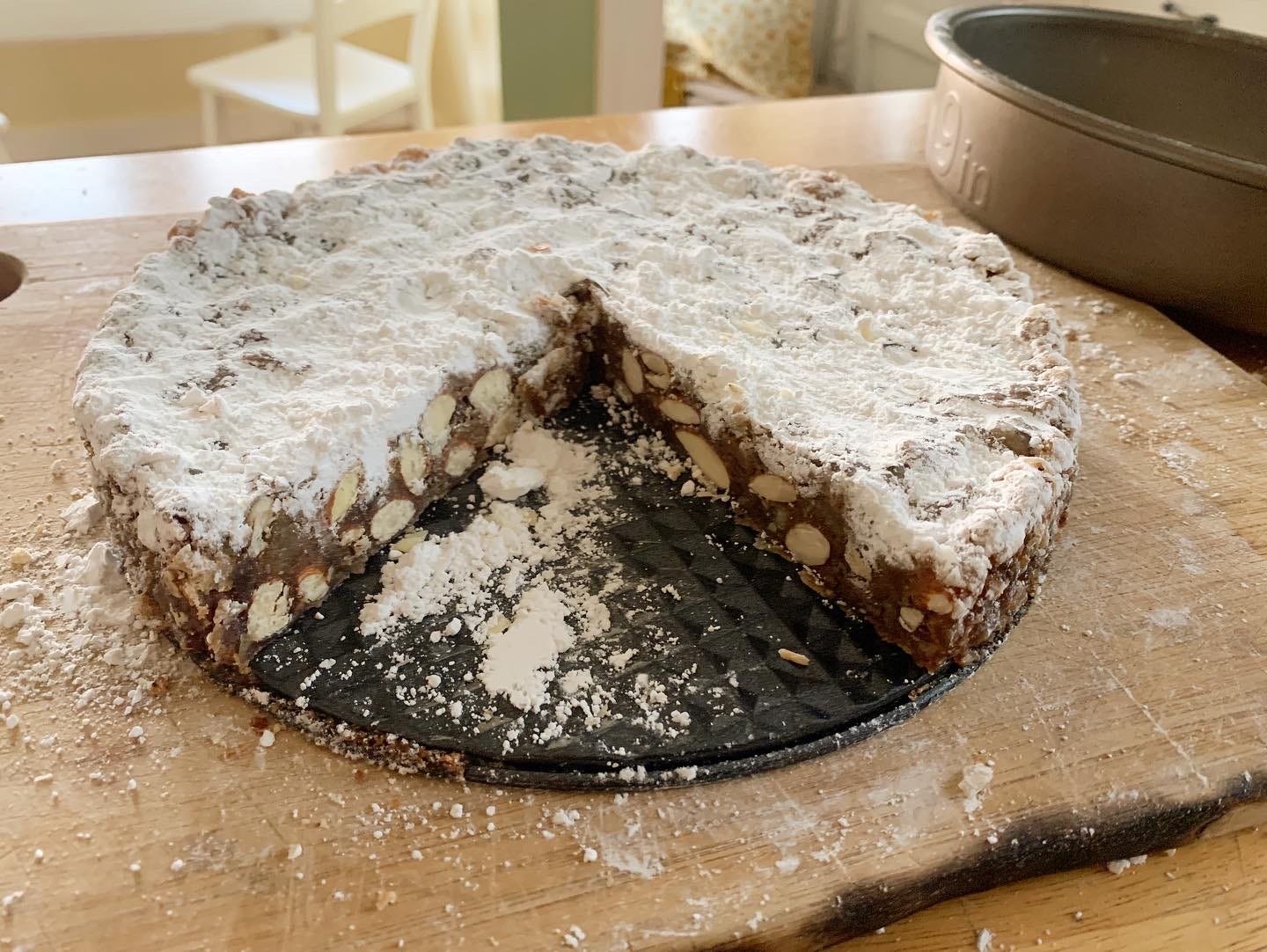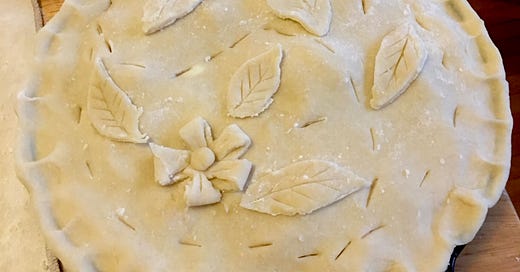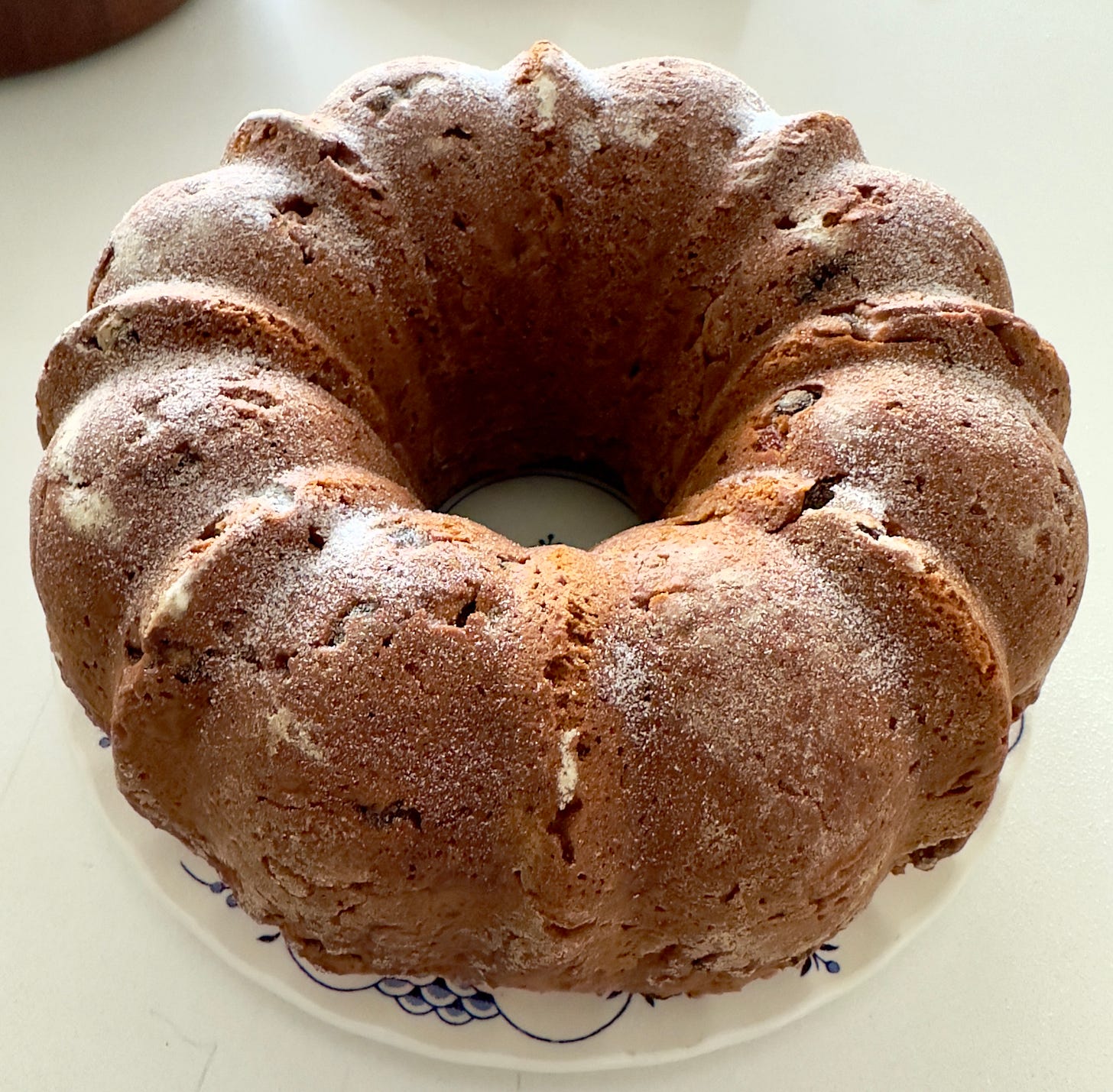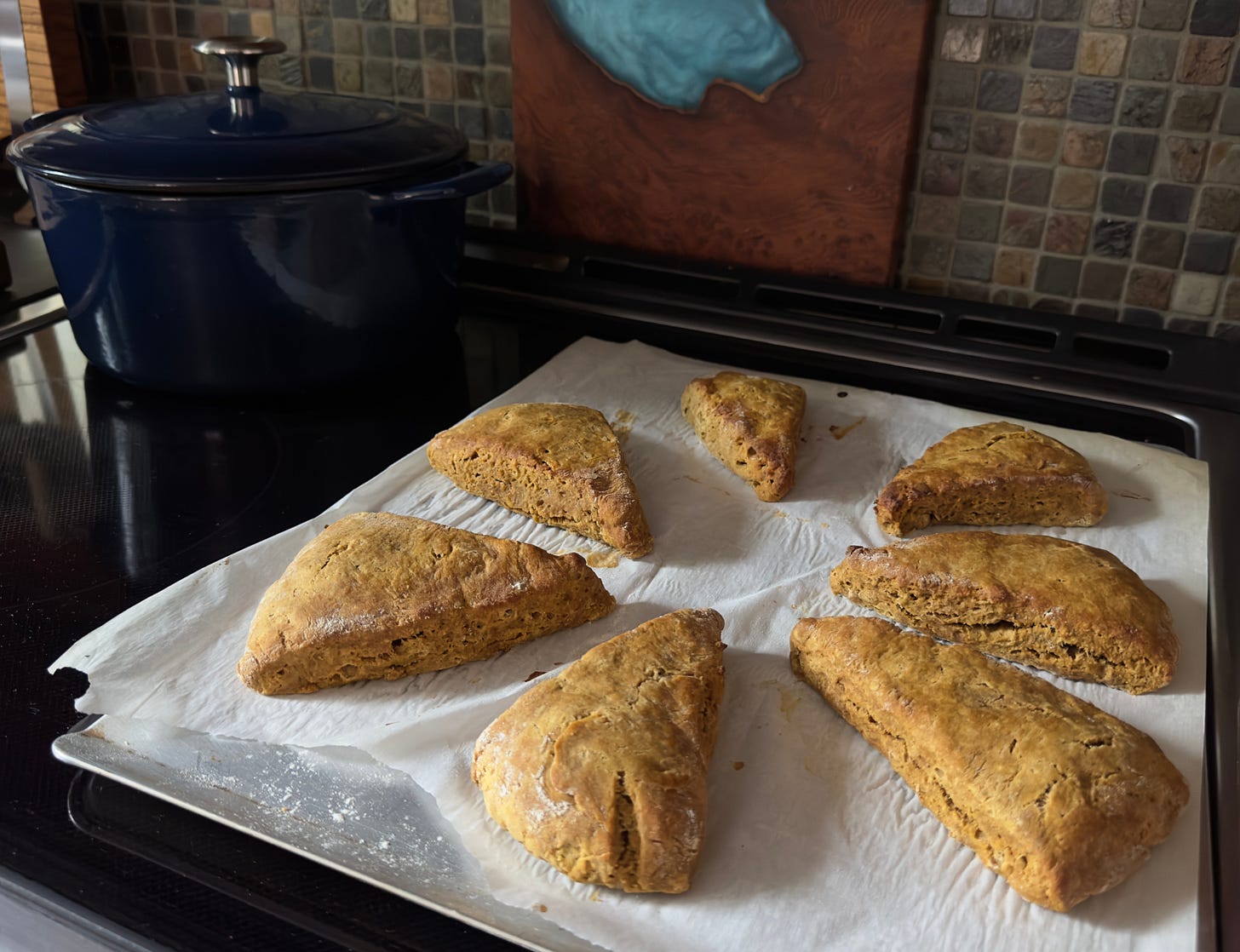I’ve always been an intuitive baker. I grew up watching - and then helping - my mother, grandmother, and great-aunt make all manner of breads, pies, cookies, cakes, and Dutch treats like banket and boterkoek. In fact, I took the constant abundance of fresh baked good so for granted that I was sometimes jealous of the kids in school who got Ho-Hos or even *Twinkies* in their lunches instead of whatever homemade treat nestled next to my baloney sandwich and Mackintosh apple.
Some of my earliest memories involve my mom showing me to cream butter and sugar together by hand - carefully waiting to add eggs and vanilla until there were no visible chunks of butter left - and explaining which ingredients you could play around with (flour, sugar, spices, vanilla), and which you had to measure carefully or risk disaster (salt and baking soda/powder). And my favorite childhood memory of ‘Auntie Goot’ (our nickname for my mother’s aunt Gertrude, who taught kindergarten in Patterson, NJ during the school year and came to live with us in the summer) is of her teaching me how to fold a top pie crust over the bottom crust and then pinch them together with my little thumbs to make a scalloped edge that would seal all the fruity goodness inside. In Michigan, pie-making follows the seasonal ripening of local fruit, and so we’d start with strawberry and rhubarb in the late spring and then move through cherry, blueberry, and peach before finally arriving at apple and pumpkin in the fall. (Monsters might also make ‘mixed berry’ pies with raspberry and such, but I don’t like to speak of evil things.)
By the time I was in grad school, I didn’t use a recipe anymore for staples - and utterly horrified a friend (hi Susan!) when we were making chocolate-chip cookies together for a departmental potluck by happily eyeing amounts for ingredients straight into the bowl as she meticulously sifted flour and leveled it off with a knife. (Quoth she, years later: “That was almost the end of our friendship!”) And while the dominant emotion of my first two years of post-grad teaching was miserable, unrelenting stress, I do also have happy memories of baking cakes and cookies in a warm, bright kitchen - both as a way of cheering myself up and as a means for keeping Toddler David entertained when I couldn’t handle yet another game of CandyLand or reading of Dr. Seuss’s ‘ABC’ book. (“Big A, little a, what begins with A? Aunt Annie’s alligator! A, a, a.”)
During the lockdowns of 2020, I experimented with sourdough starter recipes like everyone else, but I also had fun perfecting panforte and ricciarelli in honor of the month we’d spent in Siena right before the pandemic hit. (The trick to panforte is to play around with the spice mixture until you find a balance you love - same with the fruit. Also, you can make your own candied citron and orange peel, but do it mostly because it makes your house smell amazing and not for the end result; buying it online is way more efficient and, frankly, cheaper.)

All of this to say, the impact of recurring varicella zoster meningeal encephalitis (current official diagnosis - sounds so fancy, right?) on my baking-related executive functions continues to comes as a bit of a shock, even sixteen months in.
It was actually an attempt to make some pumpkin bread last November that made me realize how big a ‘hit’ my brain had taken from the initial rounds of meningitis and resulting encephalitis. If you’re not a baker, pumpkin bread is a great place to start: the recipe is dead simple, and even the baking time allows for wiggle room. And yet, I totally screwed it up: I read the recipe, immediately forgot the order of operations, and added all the ingredients together at once - a horrible idea, because it guarantees that things won’t mix well together. And they didn’t. The result was edible, but not what one might call ‘good’. And it was absolutely startling to me; I don’t just know better with my head - I know better with all the way down to my toes.
Because I am me, this sub-optimal result made me determined to succeed. Over the next few months, I attempted pumpkin bread repeatedly - and messed up in new and amazing ways each time. Once, I forgot to add the eggs. Once, I said to myself, “Ok, put the wet ingredients in this bowl, and the dry ones in that bowl,” and then watched myself pour the pureed pumpkin right into the flour. Once, I forgot to add the sugar (literally the second ingredient, mentioned in the very first instruction of the recipe) until I tasted the batter. Another time, I had the batter already poured into two loaf pans and couldn’t figure out why they weren’t as full as usual before realized I’d forgotten to add the freaking pumpkin.
Eventually, three months and six or seven attempts later, I did succeed in getting all the ingredients in, and in approximately the right order. I even remembered to start the timer when I put it in the oven!
By this point, Andy and I were both thoroughly sick of anything in the pumpkin bread neighborhood. And so I brought my success as a thank-you to the wonderful staff at my neuro-ophthalmologist’s office - all of whom I knew by name (and vice versa - I feel like Norm walking into Cheers when they see me and cry, ‘Christina!’) since this was February and I’d been seeing them every week or two since August.
I haven’t baked anything else in the past sixteen months. It’s weirdly exhausting to try to follow a recipe, and my brain has had enough to deal with looking for a new place to live and then moving.
This past weekend, however, it was properly cold and rainy - the perfect baking weather - and I felt the familiar desire for a house filled with delicious smells and yummy treats. And, because it’s almost Thanksgiving, I thought I might try some pumpkin scones. (It’s still far too early to eat pumpkin bread again, lol.) Andy, not feeling well and snuggled up in bed with Tor, brightened visibly when I told him my plan. A beat later, however, a look of apprehension crossed his face. “Don’t forget the pumpkin!” he called, as I headed downstairs. (Seriously - you forget the main ingredient in a recipe ONE TIME!!)
Things started off just fine: I got all the ingredients out and assembled them on the counter in their order of use, checking the recipe approximately eight million times to make sure I had everything. And then I started putting them together. Flour, check. Baking powder, check. Spices and salt, check. Butter to blend in, check. (Andy and I have been watching the Great British Bake-off religiously this fall, and so I even channeled my inner Georgie and mixed it together with my fingers to ensure that I didn’t overwork the dough.) Then it was time to add the pumpkin. I opened the can and dumped the whole thing in.
CRAP! As soon as I did that, I realized that I was only supposed to be adding 3/4ths of a cup, not whatever an entire can of pureed pumpkin was. (More than double that, the googles informed me later. ) And here is one of the most striking ways in which my brain injury manifests: in the heat of the moment, I lack the ability to run the sort of mental calculations that correct for user error.
There I was, with a bowl full of all the proper ingredients for pumpkin scones, plus twice the amount of pumpkin. Did I double the recipe? No! That would have been a really smart idea, but it didn’t occur to me even afterwards until my child suggested it when I was telling him this story. Did I figure out approximately how much extra I’d added and remove the excess with a measuring cup? No! Again, didn’t even occur to me.
Did I think, “Gah! Too much pumpkin!” and dump in a bunch of almond flour? Yes!! And then did I think, “Wait - I should probably add more oat milk now, too”? Yes!! (Why, though? WHY did I think this?) And then did I add some more wheat flour to make the batter more or less the right consistency?
I did.
And then I shaped the scones and put them in the oven. With nary a thought for how long I should bake them.
I realized after a few minutes (probably only a few minutes? my sense of time is pretty unreliable these days) that I’d forgotten to set the timer - and, of course, I had no idea about even the ballpark time I’d put them in. The scones were only supposed to bake for 13-15 minutes, though, so I looked at the clock and told myself I’d check them in 10 minutes. A few moments later I went to look at the clock to see how long it had been and realized that I had no idea what the time had been when I’d told myself ‘ten minutes’. I thought for a second that I remembered, but then I did the math and realized that the time I was thinking of would have been 30 minutes earlier, and I knew it hadn’t been that long because nothing was burning. (HaHA! My executive functioning is seriously compromised, and my working memory is for crap, but my powers of induction are still somewhat intact!)
Now, if you’re thinking, “FOR THE LOVE OF HEAVEN, CHILD, USE A TIMER!”, I completely agree that this would have been a good move. But in the same way that doubling the recipe didn’t occur to me, so too did the time-honored tradition of ‘setting a timer’ elude me in the heat of the moment. So I simply checked every few minutes until the edges of the scones started to brown, and then I took them out, figuring that an underbaked scone was better than an over-baked one.
Andy, meanwhile, had been napping peacefully upstairs while visions of pumpkin scones danced in his head. I chose the one that looked the most done, put it on a plate, and carried it up to him with a cup of fresh coffee, feeling extremely proud of myself. I hadn’t even tried one first myself, so he could be the first to enjoy the harvesty goodness.
I looked eagerly at Andy as he bit into one, waiting for the ‘mmmm’ affirmation all good bakers are used to. Instead, a strange expression crossed his face; I asked how it was, and he said: “Um, they maybe could have baked for longer?” “Shoot!” said I, at this point still thinking that the only thing wrong with them was that I’d underbaked them. And then I took a bite.
Now, I’ve never actually eaten wallpaper paste, but this is more or less how I imagine baked wallpaper paste would taste. It turns out that if you’re panicking and throwing extra flour into a recipe to soak up excess moisture, almond flour is a truly horrible choice. It’s dense, heavy, and it completely deadens the flavor of things like - say - pumpkin. Also, if you more than double the amount of flour of any sort in a recipe without adding more of - say - anything else, like butter or spices or salt or baking powder or sugar, the end result is basically just lumps of warm neutrality.
We tried baking them longer the next morning to see if it would help, but it just made the neutral lumps warm again, and they were actually better cold. Andy gave up after that, and even Tor (who loves to be included in all things pastry) wasn’t interested, so I ate them all myself over the next few days. They weren’t inedible - just very, very bland. (And great for encouraging digestive regularity!)
This certainly won’t be my last attempt to bake, but I may stick to soups and stews and other more forgiving enterprises for the time being. I did manage to make an incredibly tasty … something … the other day when I accidentally poured way too much salt into a root vegetable stew I was making, and added coconut milk and basmati rice to compensate for it. So I’m clinging to that as a ‘win’, even if I could never make it again because I can’t remember what most of the final ingredients were. Also, I’ve been napping like a champ, so I’m going to continue to hone my skills in that area. Winter’s coming; it’s hibernation time!
~~~~~~~~~~~~~~~~~~~~~~~~~~~~~
And that’s the news from Brain Damage Diaries Land. Until next time, be nice to your noggins, and follow me for more tips on how NOT to bake!







Thanks for another fine story, and I hope you and Andy enjoy a fine Thanksgiving.
You are still a terrific writer, though! Thanks for sharing. Happy holiday!